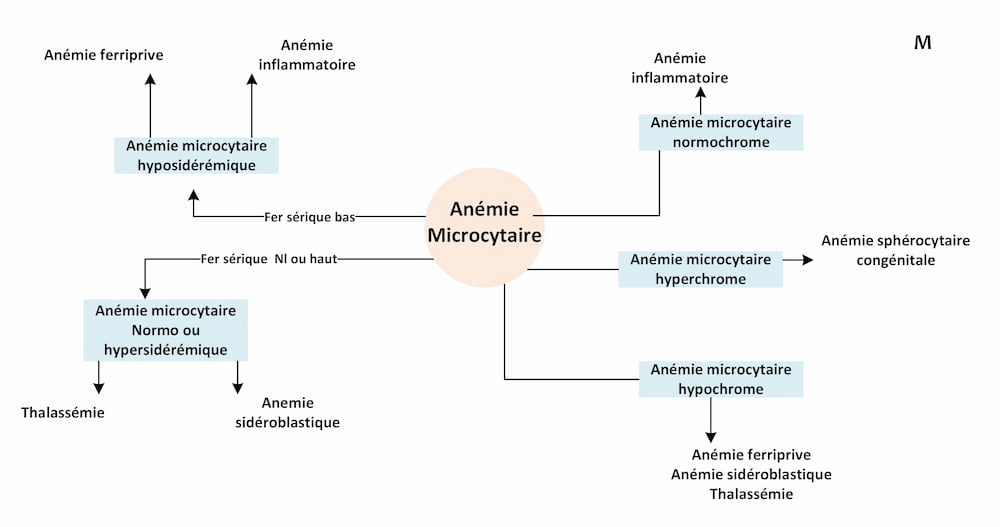Content :
Microcytic anemia is a type of anemia characterized by the association between low levels of hemoglobin and abnormally small red blood cells (microcytes) in the blood. In this article, we explain the causes of microcytic anemia, its symptoms, diagnosis and possible treatments.
◉ What is microcytic anemia?
Microcytic anemia is recognized as one of the most common forms of anemia. In this type of anemia, in addition to the reduction in the amount of hemoglobin, there is also a decrease in the size of the red blood cells compared to their normal size.
- Anemia is characterized by hemoglobin levels below normal values depending on age and sex.
- The term "microcytic" refers to a condition where the MCV is below physiological values, consistent with age and sex (<80 fL in adults).
Iron deficiency is the main cause of microcytic anemia, but other factors such as genetic conditions or inflammatory diseases can also contribute to the development of this form of anemia.
Understanding the underlying mechanisms and varied causes of microcytic anemia is essential for accurate diagnosis and adequate treatment.

◉ Classification of microcytic anemia
Microcytic anemia can indeed be classified according to the level of iron in the body (A. hyposidemic and A. hypersidemic) as well as the amount of hemoglobin in the red blood cells (A. hypochromic, normochromic and very rarely hyperchromic).
- Depending on the level of iron in the body: hyposidemic microcytic anemia and hypersidemic microcytic anemia.
- Depending on the amount of hemoglobin in the red blood cells: hypochromic, normochromic or hyperchromic microcytic anemia (very rare).

◉ Causes of microcytic anemia
The main causes of microcytic anemia include:
◉ Iron Deficiency Anemia
Iron deficiency is the most common cause of microcytic anemia, as it directly affects hemoglobin synthesis. This condition can result from insufficient food intake, poor absorption, or excessive blood loss (primarily from the gastrointestinal tract).
◉ Sideroblastic anemia (defect in heme synthesis)
This is a type of anemia that occurs due to abnormal use of iron during the process of red blood cell formation (erythropoiesis)
◉ Anemia of inflammation (Anemia of chronic diseases)
It develops due to a prolonged illness, such as an autoimmune disease or other illness, that persists for more than three months. The resulting inflammation can disrupt the body's ability to use iron efficiently to produce enough hemoglobin and red blood cells, leading to anemia.
◉ Thalassemia
In this condition, the body produces an insufficient or abnormal amount of hemoglobin chains, which can lead to excessive destruction of red blood cells. As a result, microcytic anemia may develop due to the increased rate of destruction of red blood cells.
◉ lead poisoning
Lead poisoning can have toxic effects on blood cells and the hemoglobin production process, contributing to the development of anemia.
◉ Symptoms of microcytic anemia
The symptoms of microcytic anemia are not specific and tend to develop gradually. Often there are no discernible signs during the initial stages:
- Feeling tired, weak and exhausted.
- Pale skin and jaundice.
- Shortness of breath
- Being dizzy.
- Rapid pulse.
- Headaches.
- Difficulty concentrating.
- Enlarged spleen.
Note: It is recommended to consult your doctor in case of the presence of these symptoms.
◉ Diagnosis of microcytic anemia
The correct treatment plan depends on an accurate diagnosis, which includes several steps and steps as follows:
1. Clinical history
The first step in diagnosing macrocytic anemia begins with an investigation of the patient's general condition and clinical history. During this process, his medical history is taken and his eating and lifestyle habits are examined to suggest the most likely causes.
2. Laboratory tests
- Complete Blood Count (CBC): This analysis measures various blood parameters, including hemoglobin level, mean corpuscular volume (MCV), reticulocyte level and MCH (Mean Corpuscular Hemoglobin).
- Peripheral Blood Smear: This procedure involves examining a sample of blood under a microscope to assess the morphology of blood cells
- Transferrin Saturation Coefficient: This measures the proportion of iron binding sites occupied by iron in transferrin.
- Serum Iron: This is a direct measurement of the concentration of iron in the blood serum.
- Serum Ferritin: Its blood level can provide information about iron stores in the body.
- Transferrin Assay: This measures the concentration of transferrin, a protein involved in iron transport.
- Soluble Transferrin Receptor Assay: This test measures the concentration of the soluble transferrin receptor, which may increase in iron deficiency.
- Total Transferrin Binding Capacity: This measures the maximum amount of iron that transferrin can bind.
- Inflammation markers: Sedimentation Rate (ESR), C-Reactive Protein (CRP), Fibrinogen.
- Hemoglobin electrophoresis: To determine the type of hemoglobin abnormalities present.
Note: These tests are usually not all performed at the same time. The choice of tests will depend on the patient's symptoms, family history, and clinical suspicion.
◉ Treatment of microcytic anemia
Treatment for microcytic anemia varies depending on the underlying cause. The main goal of treatment is to correct abnormal blood values and relieve associated symptoms.
In more severe cases, where hemoglobin levels are very low or symptoms are particularly pronounced, a blood transfusion may be required
It is important that treatment is personalized to the patient's specific condition, and that this is discussed with a medical professional to ensure the best possible approach.
◉ Conclusion
In conclusion, this was the most important information about macrocytic anemia, its causes, symptoms and types, so we have provided you with a complete guide to this disease in all its aspects and answered the most common questions related to it, With our best wishes for good health and well-being.